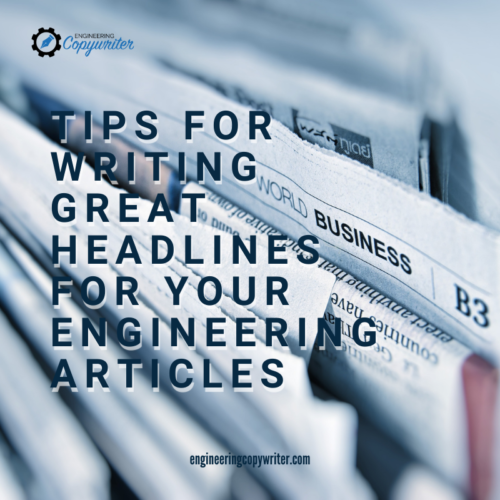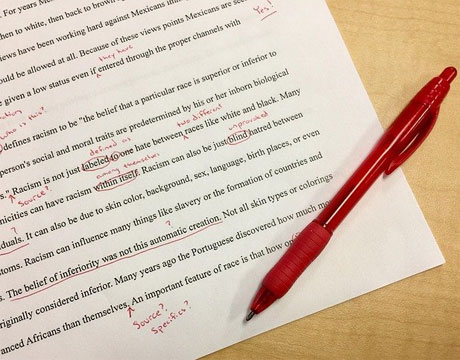
What is the first thing you see when you scan or search for an article? The headline or title, of course! By writing great headlines you will be able to portray your article in the very best way, just like the first impression you get when you meet someone for the first time. A great headline gives you an inkling of what you are in for and often it’s that first glance which either takes you further, or turns you off. They say we shouldn’t judge a book by its cover, but most of us do, and the same applies with the headline of an article or blog.
Blogging should now be a vital part of your engineering firm’s content marketing strategy. With millions of people flocking to the internet to find out key information regarding products and services, your articles and blog posts should serve your potential client/customer’s needs. However, you need to ensure that you use the correct keywords and SEO practices; otherwise, you risk being drowned out by the noise of your competition.
Imagine a scenario in which you have grafted for hours on end in order to produce an informative, well-written article or blog post which has gained zero engagement. Does this sound familiar? If so you’re probably feeling unmotivated to write any more.
The key to the SEO success of your articles or blog posts lies within writing great headlines.
So, headlines are powerful, and the better we write them, the greater our readership and conversions will be. Here are four tips which can help you to write great headlines:

Start with a rough draft of your headline. This is more specific than your general topic and gives you the direction your writing will take. The working title is important to guide your thoughts and keep you on track while you work on the next aspects of refining it.
For example, if you consider the topic “Data Engineering,” you could develop the following headlines:
Note how different and unique each of those headlines are. This is what makes them suitable for blog posts and articles rather than overarching topics.

Accuracy is paramount when writing on non-fiction topics. Make sure that you do not make any untrue claims in your headline or set your reader up for something which you will not be able to deliver in the blog or article. The most important thing about the headline is that it should be an accurate reflection of the content of the article. If not, you are likely to disappoint your readers and lose their trust.
One tactic you can adopt to guarantee factual correctness is to add a bracketed explanation to your headline. In a study of over 3.3 million paid link headlines, it was discovered that headlines in this format performed 38% better than those without the bracketed explanation.
By using this tactic, you are clearly setting expectations, and therefore, the reader can be sure of what they will be viewing even before they click through.
Another method you can implement to improve the factual nature of your article is to draw the reader in with a specific number or piece of data. According to research, a headline which includes a number has the potential to generate up to 73% more clicks.
Now you can start having some fun with a few finishing touches that will set you well on your way to writing great headlines with an enticing sizzle.
There is something about alliterations which make them easier to assimilate and add a touch of allure.
For example, if your article topic focuses on engineering software that provides value, you could use the following headline with alliteration: “Enticing engineering software that promises to add value.”
Use strong words to make a strong impact, even if they are negative ones. However, these strong phrases should be used in moderation to retain their impact.
Examples could include: “The Most Hated Engineering Jobs,” or “Fantastic Engineering Jobs You are Bound to love”… both pack a hefty punch.
If you have visual content in your article, this could feature in the headline with a word such as ‘photos’ or ‘images.’
For instance, if your blog post or article is focused on structural failures you could make it clear that it contains photos by using the following headline: 5 Photos of the Most Catastrophic Sinkholes of All Time.
The word ‘who’ has also been found to generate more traffic than the word ‘why.’
For example, an article titled “2019’s Most Advanced Engineering Developments” could translate as the following: “3 of the Best Firms who are Responsible for the Most Advanced Engineering Developments of 2019.”

Finally, you need to be aware of the length of your headline. It’s good to keep it under 70 characters if you want your post to rank well in searches. If it is longer than that, it will get cut off in search engine results. Some studies have shown that titles with between 8 and 14 words got the most shares and likes on Twitter and Facebook, with eight words being the happy median.
With that being said, there is no size fits all approach, and we recommend that you write a number of headlines as a trial and error process to see which perform best.
For example, to shorten headlines you often simply need to rephrase them. For instance, if you had a headline which read “Think you have to have a degree to be an Engineer? Here are 5 stats that prove that’s not the case.”
A shortened version could be: “5 Stats that Prove Engineering isn’t just for Graduates.”
If you need help writing engineering articles with great headlines, contact us today. We can help!
Content marketing helps marketers showcase their brand's value while also building trust with...
The digital age has transformed the way marketers engage with B2B audiences. As...